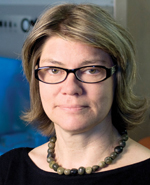January 6, 2009 - By Krista Conger

Scientists at the School of Medicine and at UCSF have succeeded in isolating stem cells from human testes. The cells bear a striking resemblance to embryonic stem cells - they can differentiate into each of the three main types of body tissue - but the researchers caution against viewing them as one and the same. According to the study, testes stem cells have different patterns of gene expression and regulation and don't proliferate and differentiate as aggressively as embryonic stem cells.
The findings, published in the January issue of the journal Stem Cells, are in contrast to those reported in a recent Nature paper, which concluded that the cells were as pluripotent as embryonic stem cells. Pluripotent cells can become any cell in the body and form tumors called teratomas when transplanted into mice.
'It's time to reinterpret the data,' said Renee Reijo-Pera, PhD, professor of obstetrics & gynecology at Stanford, 'and to accept that we're beginning to discover many types of stem cells. Although they are all related to each other, they all have unique therapeutic applications in which they surpass other family members.'
Reijo-Pera, who is the director of Stanford's Center for Human Embryonic Stem Cell Research and Education, collaborated with male infertility specialist Paul Turek, MD, professor of urology at UCSF and director of The Turek Clinic in San Francisco, to conduct the research. They are co-senior authors of the study.
The testes stem cells seem to hover in a gray area between true pluripotency and a more limited, tissue-specific multipotency exhibited by many types of adult stem cells. They called the cells 'multipotent germline stem cells.' (Germ cells differentiate to make sperm and eggs.)
Playing to the testes stem cells' strengths - their likely ability to differentiate into cells involved in male reproduction - may make more sense than trying to pigeonhole them as embryonic-stem-cell-wannabes.'These cells could potentially treat infertility or other diseases in men,' said Turek.
But the lure of pluripotency is strong. An easily accessible source of unmodified, pluripotent human cells would allow researchers to create cell lines and tissues identical to others in a donor's body. Theoretically such cells could be used as a perfectly matched therapy for that particular donor - perhaps to generate new cartilage to repair a knee injury or new neurons to treat nerve damage. Alternatively, the technique could be used to derive cell lines carrying specific disease-causing mutations - from a man with Parkinson's, for example - on which to conduct research.
Coaxing specialized, or differentiated, adult cells back to a more malleable, embryonic-stem-cell-like state (a process called 'inducing pluripotency') would also let scientists realize the therapeutic benefits of embryonic cells without the ethical problems that plague cells derived from embryos. Until recently, however, the reprogramming of differentiated cells required the use of viruses to introduce specific genes into the cells, which may limit their therapeutic usefulness.
The researchers used cells from biopsies done to diagnose male infertility in 19 clinic patients. Each patient's cells were cultured in a manner similar to embryonic stem cells; two of the 19 samples yielded cell lines with many characteristics of the pluripotent cells. One of these two patients withdrew from the study and his samples were discarded.
Further study on the remaining cell line indicated that it expressed many, but not all, genes associated with pluripotency. The cells could also be induced to differentiate into decidedly non-testicular neural cell precursors and they expressed the telomerase enzyme essential to keep pluripotent cells young and unspecialized. Still, when the researchers examined the cells' patterns of methylation - a modification to DNA that affects gene expression - they found that the newly derived cell line was less-thoroughly methylated as compared to human embryonic stem cells in one region and more heavily methylated than embryonic stem cells in another region.
Finally, when the researchers injected the human stem cells into mice with compromised immune systems, they showed only a limited ability to form a teratoma - a kind of tumor formed of many cell types. Teratoma formation resulting from the aggressive proliferation and differentiation of transplanted stem cells is a hallmark of true pluripotency. Together, the results suggest that the stem cells isolated from male testes have some, but not all, the characteristics of true pluripotent cells.
'It's not yet possible to completely re-create embryonic stem cells from germline cells,' said Reijo-Pera, 'These cells differ in gene expression, methylation and in their ability to form teratomas. But it's the fact that they are different that makes them so interesting. Suggesting otherwise would do a disservice to the research community by overlooking the fact that these cells are a unique cell type that could be useful in the study of human germ cell formation.'
The study also involved graduate students Nina Kossack and Cory Nicholas; research assistant Ha Nam Nguyen; and postdoctoral scholar Shawn Chavez, PhD. The research was funded by the Gottlieb Daimler and Karl Benz Foundation, the California Institute of Regenerative Medicine and the National Institutes of Health.
About Stanford Medicine
Stanford Medicine is an integrated academic health system comprising the Stanford School of Medicine and adult and pediatric health care delivery systems. Together, they harness the full potential of biomedicine through collaborative research, education and clinical care for patients. For more information, please visit med.stanford.edu.